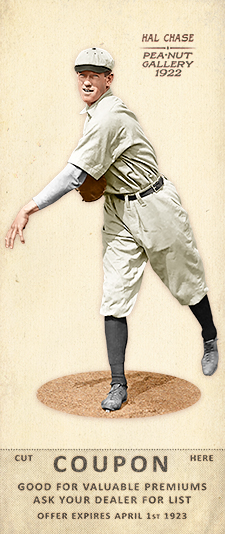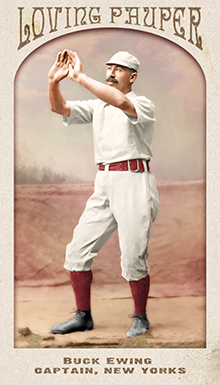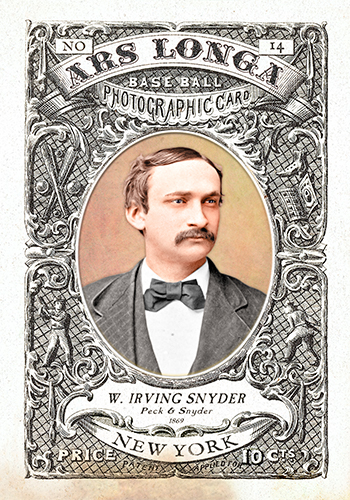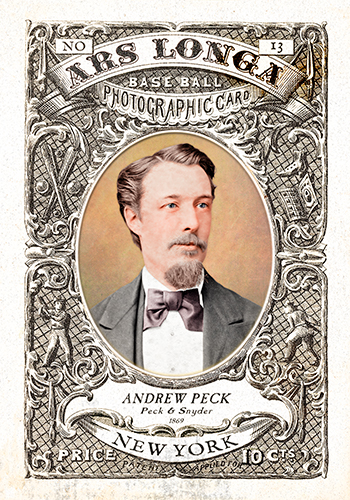
- Series: 1919 Black Sox Scandal
- City: New York
- Team: Highlanders
- League: American League
Harold Homer Chase (1883-1947) may have been among the best first-basemen ever, but his “errors” place him as mediocre at best. His own words are his epitaph: “I am an outcast, and I haven’t a good name. I’m the loser, just like all gamblers are.” A star for the NY Highlanders for the first nine years of the franchise, admired by peers such as Babe Ruth and Walter Johnson, Chase even went on to out-poll dozens of later entrants into the Hall of Fame. Such was his prowess at first and plate. But his compulsion to wager, and the ease of access to illicit betting (the bookies were in the front row) consigned this great player to ignominy.
- Chase’s spiral from NY idol to deportee from Mexico evidenced his inability to stay straight in an era when the crooked path was wide and inviting
- Chase was banned from baseball for life by commissioner Kennesaw Mountain Landis in 1922 for his (unsubstantiated) role in the 1919 Black Sox scandal
- Despite the controversy that consumed his career, Chase received more HOF votes in 1936 than 18 future HOFers, and more votes in 1937 than 32 future HOFers, but he never appeared on the ballot again

- Series: 1880s: Loving Paupers
- City: New York
- Team: Giants
- League: National League
- Hall: National Baseball Hall of Fame
William Ewing (1859-1906) was the premier catcher of the 19th century, honored for decades after his early death as even, perhaps, the greatest player of all time. A scourge at bat, Buck hit over .300 ten times. He played behind the plate with courage and style, crouching close to the hitter so as to shave precious seconds off his inerrant throws. Ewing had debuted with the remarkable Troy Trojans in 1880 and joined four future Hall-of-Famers in moving to NYC in ‘83. The sturdy catcher may have been the primary inspiration for Jim Mutrie’s “my Giants!” exclamation that led to the new identity of the Gothams. An arm injury on a raw spring day curtailed his tenure behind the plate from 1891 on. Such a magnetic figure couldn’t escape the turmoil of the Players’ League controversies and Ewing was sometimes pilloried for lax effort. Despite such caviling, Ewing left as indelible a mark on the game’s first century as anyone. Upon his induction to Cooperstown (among the first six of the “pre-modern” era), he was hailed by Connie Mack as the greatest catcher he had seen and he had seen most.
- “Buck” was a derivative of “Buckingham,” bestowed on the budding star by an admiring scribe who wanted to add gravitas to the youngster’s reputation
- Played all nine positions and managed 3 different teams over 7 seasons
- Was the first catcher elected to the Hall of Fame; and the second 19th century player elected (after Cap Anson)
- Elected to Hall of Fame: 1939
Auction History
Cartophilia
Old Judge Pose: 149-5

- Series: 1880s: Loving Paupers
- City: New York
- Team: Giants
- League: National League
- Hall: National Baseball Hall of Fame
Roger Connor (1857-1931) was the home run king of the 19th century, clouting 138 in his 18-year career. His record stood for 23 years after his retirement, until Babe Ruth surpassed him in 1921. Connor anchored first-base for five teams, winning pennants twice with the Giants. His flair for the dramatic was never more evident than when he struck the first-ever major league grand slam with his team down by three with two outs in the ninth. Born in Connecticut, Roger played for local clubs until joining the Troy Trojans in 1880. That NY hamlet witnessed five future Hall of Famers on their squad with Connor playing alongside Dan Brouthers, Buck Ewing, Tim Keefe and Mickey Welch. After moving to the Gothams, the 6’3” Connor inspired owner Jim Mutrie to proclaim the team “my giants!” and a new identity was born.
- Much more than a slugger, Connor won the NL batting title in 1885 and consistently hit .300+ while exhibiting remarkable speed for a big man (still fifth all-time in triples)
- Connor lived to see Ruth claim his HR title. It was thought at the time, however, that Connor had hit 131 HRS and Ruth's record was celebrated at 132. Writing for SABR in 1975, John tattersall discovered that Connor had actually hit 138 HRs.
- Jay Jaffe's JAWS system ranks Connor as the 5th greatest 1st baseman of all-time, just behind Cap Anson and just ahead of Jeff Bagwell
- Beloved by fans and the baseball press, he had a particularly strong advocate for the Hall in fellow legend, umpire Bill Klem
- Elected to Hall of Fame: 1976
Auction History
Cartophilia
Old Judge Pose: 88-3

- Series: Mort's Reserve
- City: New York
Walter Irving Snyder and his partner Andrew Peck founded the first true sporting goods store in 1866 at 124-128 Nassau Street in New York City. The pair wanted to promote their business and thought trade cards might help. In 1869, this was a common technique for many retailers, but Peck and Snyder wanted something distinctive. They came up with the idea of using the image of Harry Wright’s nationally renowned new professional baseball squad, the Cincinnati Red Stockings, as their motif. A few versions were printed, the most prized of which today features the players in uniform and their names below the photo. No one could have known that this modest marketing scheme would pave the way for one of the great products and hobbies in American history, as Peck and Snyder unwittingly established a framework for the mass-produced baseball picture card. Following the Red Stockings release, the company issued cards featuring the hometown Mutuals and rival Chicago White Stockings in 1870. Other manufacturers soon followed suit and baseball cards became an advertising mainstay.
Snyder forged a fortuitous relationship with baseball-star-turned-entrepreneur Al Spalding. Irving joined the 1888 “Spalding’s World Tour” to help promote his business interests (and find a buyer for 30,000 pairs of roller skates, per Jerry Houseman of Sports Collectors Daily). The friendship with Spalding later led to Al buying out Peck and Snyder, allowing the founders to devote themselves to manufacturing.
- In a memoir of the ‘88 tour, Snyder wrote of playing the game for “about 200 Arabs” in the shadows of the pyramids. He was pleased to note that, unlike the English, the Egyptians never once referred to baseball as “really just Rounders, you know.”
- In the 1913 edition of Spalding’s “official base ball guide,” his old pal Snyder penned a promo: “I have read the book from cover to cover with great interest.”
- Snyder is credited by Aussie cricketer gear manufacturer BaggyCaps as having invented the cap cricketers proudly sport today, acknowledging it was created for baseball. Thus Irving helped bring full circle the influence of British “rounders” and America’s pastime
- A Peck & Snyder 1869 Cincinnati Red Stockings card recently sold for $75,000
Following in his older brother’s footsteps, Ward B. Snyder established a sporting goods store at 84 Fulton St. in New York City in 1875. The annually published Ward B. Snyder’s Illustrated Price List and Catalogue of Base Ball and Sportsmen’s Goods is a highly prized collectible today and is a fantastic color documentary of baseball uniforms and equipment of the 1870s.

- Series: Mort's Reserve
- City: New York
Andrew Peck (1836-1918) and his partner Walter Irving Snyder founded the first true sporting goods store in 1866 at 124-128 Nassau Street in New York City. The pair wanted to promote their business and thought trade cards might help. In 1869, this was a common technique for many retailers, but Peck and Snyder wanted something distinctive. They came up with the idea of using the image of Harry Wright’s nationally renowned new professional baseball squad, the Cincinnati Red Stockings, as their motif. A few versions were printed, the most prized of which today features the players in uniform and their names below the photo. No one could have known that this modest marketing scheme would pave the way for one of the great products and hobbies in American history, as Peck and Snyder unwittingly established a framework for the mass-produced baseball picture card. Following the Red Stockings release, the company issued cards featuring the hometown Mutuals and rival Chicago White Stockings in 1870. Other manufacturers soon followed suit and baseball cards became an advertising mainstay.
- Peck posted inning-by-inning telegraph reports of the big game between the NY Mutuals and Wright’s club in 1870 to a fevered crowd of NY “cranks.” Final tally: Cincinnati 15, NY 12.
- Peck started his business with ten cents to his name and died a rich man
- Perhaps not rich enough to buy his own trade cards today though: a Peck & Snyder 1869 Cincinnati Red Stockings card recently sold for $75,000




